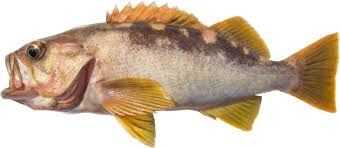Olive Rockfish

Species Details
Sebastes Serranoides
Sebastidae
Scorpaeniformes
Nearshore, Kelp Forests, Coral Reefs
5 lbs.
10" - 24"
Olive Rockfish (Sebastes serranoides) Fish Description
The Olive Rockfish is a medium-sized saltwater fish. It has a narrow elongated body just like a bass, which is also why it’s commonly mistaken as a bass. Like its name, it has an olive to brown color and beige underside. Their close relative, the yellowtail rockfish, is often mistaken for the Olive rockfish. They have 12-14 dorsal fin spines and 3 anal spines. To differentiate the two, the olive rockfish’s caudal fin is more olive-brown in color, rather than just yellow like the yellowtail’s. They also do not have brown speckles like the yellowtail rockfish.
Diet and Size
The olive rockfish are carnivorous. They feed on crustaceans, smaller fishes, worms, and invertebrates such as octopus and squid.
The biggest olive rockfish is 2 feet long and the heaviest was 5 pounds and 14 ounces. On average, they’re only 10 inches long. A lot of information is still unknown about the olive rockfish, like its average weight and concrete eating pattern.
Interesting Facts About the Olive Rockfish
- Their name serranoides is derived from the combination of Latin and Greek word, which means “resembling a bass”
- They are mostly found as solitary individuals or in small groups. Often mixed in with other rockfish species such as the blue rockfish and copper rockfish.
- As game fish, they are sought after for their meat which is said to have a mild meaty taste. They’re often best to cook fried.
Habitat and Distribution
They are mostly found in the nearshore waters of the eastern Pacific Ocean. Their depth of range is from the surface to 570 feet deep, resting in kelp forests and coral reefs. They migrate vertically, staying at the bottom during the night to feed, and rests near the surface during the day (though they’ve also been observed feeding during the day). They thrive in temperatures between 54.5° to 70.7°F. Their mating season usually happens during fall. The olive rockfish are resident type species, they rarely move out of their territory.
Their range is from Southern Oregon to Baja California, Mexico. The primary fishing spots for the olive rockfish are found in California. Fishing spots for the olive rockfish are Redding Rocks, Santa Barbara, Monterey Bay, and north of the Channel Islands. A good place to catch them is also through manmade structures such as piers and wharves. Piers that you can check to catch this fish are San Clemente Pier, Cabrillo Mole, Goleta Pier, Stearns Wharf, Monterey Wharf, and Santa Crus Wharf. You can even find them on oil platforms.
Fishing Techniques: How to Catch Olive Rockfish
Anglers often catch olive rockfish through either boat fishing or casting by the rocks or pier. To fly fish an olive rockfish, set up your line that it can handle rocky reefs or kelp forests. Look for areas where there are a lot of kelps or underwater vegetation, or rocky crevices. Cast on these sites and let your presentation drift for a bit before you reel in. Slack your line and tug a bit to check if they strike.
Here is the recommended equipment by anglers for fly fishing the olive rockfish. Use 6- weight light action rod of 6- to 8- feet in length. For your line, use a 10- to 20-pound test braided line. If you need to get lower, use some sinkers. Use hook sizes around 6 to 4 circle hooks.
For lures, anglers found success using swimbaits and streamer flies. The best baits to use for the olive rockfish are anchovies, ghost shrimps, and bloodworms.






